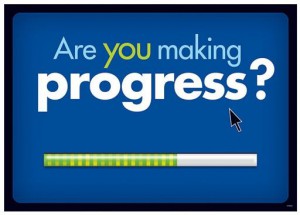The #1 Motivator in the World

Rank-order the following employee motivation factors:
Most people in the room chose Recognition, then Interpersonal Support, then Clear Goals, then Incentives and Progress last. Seven people chose Progress. Less than 10%. Perfect right? Since this is my opportunity to share Teresa’s work and illuminate the truth that the #1 motivator is a sense of progress. More specifically “progress in meaningful work.”
This was supposed to be the moment of ah-ha, the moment of illuminating insight, but instead there were a lot of frowns, and after a beat one executive raised her hand to say, “But without Clear Goals, progress is meaningless. Clear Goals must be the most important.” I couldn’t stop myself and said, “Yes, you are speaking from the perspective of the team leader. You know and understand there must be clear, actionable goals in order to make progress. But the question was ‘What is the most powerful motivator of the members of the team?”
Teresa and her colleague Steven Kramer analyzed 12,000 diary entries from 238 employees in 7 companies to come to the qualified conclusion that the most valuable work motivator is indeed, a sense of progress (in meaningful work). And even though I knew from her research that only 5% of leaders surveyed understood that, still I persisted in pressing the point.
When I met with Teresa, she said she didn’t present her findings in such a “gotcha” format because of that very reason. And her goal was to spread this important message until the needle pushed way past 50%, and then perhaps she would try it in a quiz-format.
Two take-aways:
1. The #1 motivator for contributors is progress (in meaningful work)
2. Never ever make your audience feel stupid
When sharing insight with anyone – either personally one on one or in a large group – allow people to feel like they have come to the insightful conclusion on their own, and build their own insights to apply to their work. Make people feel stronger, smarter, better-equipped to propel their team and drive innovation.


 Whatever field you work in, your expertise is expected, it’s a given. So too your diligence. It is your initiative and creative ability to bring unique and signature solutions to solve unexpected problems that is your brand, and increasingly your company’s brand and identity. The question is how to find it? Or a better question – how can we create collaborative learning environments where we can have new ideas on a regular basis? Not in a mechanized on-demand sort of way, but rather create an ecosystem which encourages exploration of the adjacent possible. More on that cool concept
Whatever field you work in, your expertise is expected, it’s a given. So too your diligence. It is your initiative and creative ability to bring unique and signature solutions to solve unexpected problems that is your brand, and increasingly your company’s brand and identity. The question is how to find it? Or a better question – how can we create collaborative learning environments where we can have new ideas on a regular basis? Not in a mechanized on-demand sort of way, but rather create an ecosystem which encourages exploration of the adjacent possible. More on that cool concept 


